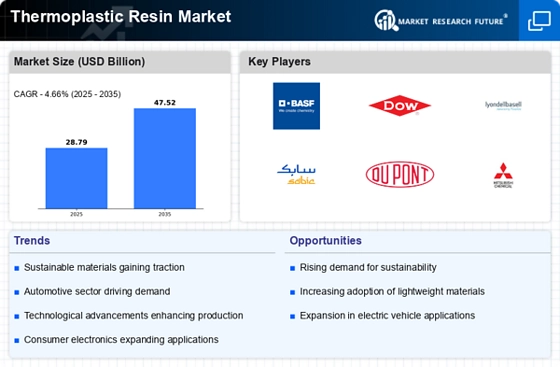Growth in Consumer Electronics
The consumer electronics sector is witnessing a notable increase in the adoption of thermoplastic resins, which is likely to propel the Thermoplastic Resin Market. With the proliferation of smart devices and the Internet of Things, manufacturers are seeking materials that provide both aesthetic appeal and functional performance. Thermoplastic resins, known for their excellent electrical insulation properties and design versatility, are becoming increasingly popular in the production of components such as casings, connectors, and circuit boards. Market data indicates that the consumer electronics segment could contribute significantly to the overall market growth, with a projected increase of around 6% in resin consumption by 2025. This trend underscores the importance of thermoplastic resins in meeting the evolving demands of modern technology.
Innovations in Packaging Solutions
Innovations in packaging solutions are emerging as a crucial driver for the Thermoplastic Resin Market. The shift towards sustainable and efficient packaging materials is prompting manufacturers to explore thermoplastic resins, which offer recyclability and reduced environmental impact. In 2025, the packaging sector is anticipated to witness a surge in the use of thermoplastic resins, particularly in food and beverage applications, where safety and compliance with regulations are paramount. Market analysis suggests that the demand for thermoplastic resins in packaging could grow by approximately 4% annually, driven by consumer preferences for eco-friendly materials. This trend indicates a broader movement towards sustainability, positioning thermoplastic resins as a key player in the future of packaging.
Rising Demand in Automotive Sector
The automotive sector appears to be a primary driver for the Thermoplastic Resin Market. As manufacturers increasingly prioritize lightweight materials to enhance fuel efficiency and reduce emissions, thermoplastic resins are gaining traction. In 2025, the automotive industry is projected to account for a substantial share of the thermoplastic resin consumption, with estimates suggesting a growth rate of approximately 5% annually. This trend is likely influenced by the shift towards electric vehicles, which often utilize advanced materials for better performance. Consequently, the demand for thermoplastic resins is expected to rise, as they offer the necessary properties such as durability, flexibility, and resistance to heat, making them ideal for various automotive applications.
Expansion of Construction Activities
The expansion of construction activities is likely to serve as a significant driver for the Thermoplastic Resin Market. As urbanization accelerates, the demand for durable and versatile building materials is increasing. Thermoplastic resins are being utilized in various construction applications, including pipes, insulation, and roofing materials, due to their resistance to corrosion and weathering. In 2025, the construction sector is expected to account for a considerable portion of thermoplastic resin consumption, with growth rates projected at around 5% annually. This trend reflects the industry's shift towards innovative materials that enhance structural integrity and energy efficiency, thereby reinforcing the role of thermoplastic resins in modern construction practices.
Regulatory Support for Sustainable Materials
Regulatory support for sustainable materials is emerging as a pivotal driver for the Thermoplastic Resin Market. Governments are increasingly implementing policies that encourage the use of environmentally friendly materials across various sectors. This regulatory landscape is likely to boost the adoption of thermoplastic resins, which are often more sustainable compared to traditional materials. In 2025, it is anticipated that the demand for thermoplastic resins will be bolstered by initiatives aimed at reducing plastic waste and promoting recycling. Market forecasts suggest that this regulatory support could lead to a growth rate of approximately 4% in the thermoplastic resin sector, as industries adapt to comply with new standards and consumer expectations for sustainability.


















Leave a Comment